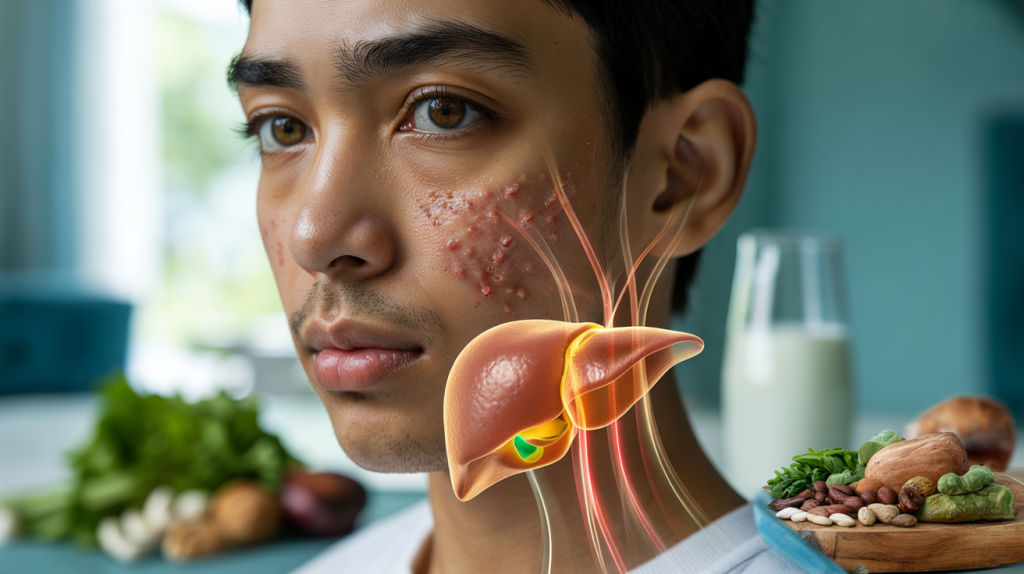Curious about acne and liver health. Get clear facts, statistics and expert-backed tips that actually help without risky “detox” shortcuts.
Breakouts spark a familiar question : is the liver clogged and crying for a detox. The short answer : acne rarely comes from a toxic liver, and quick cleanses do not clear skin. Dermatology points first to hormones, oil production and hair follicles. The liver still matters, but not the way social posts suggest.
Here is the reality readers look for : acne is extremely common, with up to 50 million Americans affected each year and about 85 percent of people aged 12 to 24 experiencing some form of it, according to the American Academy of Dermatology. The liver works nonstop at processing hormones, medications and nutrients. Certain conditions and treatments link liver function to skin, yet evidence does not show that liver detoxes heal acne. The path forward is more practical and science based.
Liver and acne : what the evidence really shows
Dermatology textbooks describe acne as an inflammatory disease of the pilosebaceous unit. Hormones increase sebum, keratin blocks pores, Cutibacterium acnes fuels inflammation. That is the engine. A damaged liver is not listed as a standard cause.
So why the confusion. The body runs on networks. Researchers have mapped a gut liver skin axis where intestinal microbes, bile acids and immune signals talk to skin. A 2022 review in the International Journal of Molecular Sciences summarized this crosstalk and called for better trials in acne. Interesting signal, not a slam dunk.
Diet plays a separate role. A 2018 meta analysis in Nutrients led by Rasmus Juhl reported that dairy consumption associates with higher odds of acne : odds ratios ranged from 1.16 for total dairy to 1.41 for skim milk. A 2007 randomized controlled trial in the American Journal of Clinical Nutrition led by Robyn Smith found fewer acne lesions after 12 weeks on a low glycemic load diet compared with a higher glycemic load plan. These findings speak to hormones and insulin signaling far more than to liver toxins.
Hormones, metabolism and the skin gut liver axis
Metabolic health touches both skin and liver. Nonalcoholic fatty liver disease rose globally with diet and weight trends. Zobair Younossi and colleagues estimated its prevalence at about 25 percent worldwide in Hepatology in 2016. That same metabolic background insulin resistance, higher androgens often worsens acne.
Polycystic ovary syndrome sits right at this intersection. The 2018 international evidence based guideline reported PCOS in 8 to 13 percent of women of reproductive age. Acne, irregular cycles and metabolic changes often cluster together. Supporting insulin sensitivity helps both skin and long term health.
Medications also connect the dots. Isotretinoin, a gold standard for severe acne, requires lab monitoring because it can affect lipids and liver enzymes. American Academy of Dermatology guidelines published in 2016 recommend baseline tests and repeat checks during treatment, commonly at baseline and after 1 to 2 months, then as clinically indicated. This does not mean the drug poisons the liver in most users. It means clinicians watch closely and adjust early.
What helps acne without “detoxing” the liver
Searches for cleanses surge each January. The evidence does not keep up. A critical review by Aidan Klein and Mieke Kiat in the Journal of Human Nutrition and Dietetics in 2015 concluded there is no convincing proof that commercial detox diets remove toxins or improve health outcomes. Acne solutions live elsewhere.
Practical changes make a visible difference over weeks, not days. And they stack with dermatologist care.
- Choose low glycemic load meals : think beans, intact grains, vegetables, lean proteins, nuts. Trials tested 12 week horizons.
- If acne flares with milk, try swapping to non dairy options. The 2018 Nutrients meta analysis linked skim milk with higher odds.
- Sleep 7 to 9 hours and keep a steady bedtime. Night shift patterns often worsen inflammation.
- Wash gently twice daily, non comedogenic products only. Friction from helmets or masks can trigger breakouts.
- Discuss topical benzoyl peroxide, adapalene or clindamycin for mild cases. Add oral antibiotics only for short courses.
- For stubborn or scarring acne, ask about spironolactone or isotretinoin. Both target root drivers.
What about liver support. Eat fiber, limit alcohol, keep vaccinations up to date and maintain a healthy weight. These habits protect the liver and overall inflammation. They do not replace effective acne treatments, they complement them.
When to seek medical advice : tests, red flags and real treatments
See a clinician fast if acne leaves dark marks, pits or cysts. Early control prevents scars. If starting isotretinoin, expect baseline AST, ALT and lipid tests and a check after about 1 to 2 months as per American Academy of Dermatology guidance from 2016. Ask what the plan is if numbers drift.
Get a metabolic check if there are irregular periods, weight gain around the waist, or signs of insulin resistance. The PCOS guideline from 2018 supports screening for glucose and lipids because treating the metabolic side can calm acne too.
When someone promises a seven day liver cleanse for clear skin, press pause. The skin responds to hormones, follicles and inflammation. The liver already detoxifies 24 hours a day. Science points to steady habits and proven therapies. That path is less flashy, definitly more effective.
